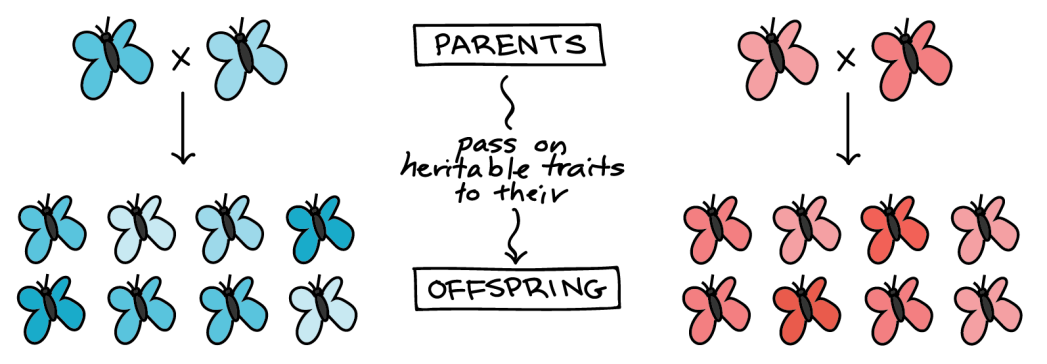The theory of evolution by natural selection is one of the most popular versions of how the world was organized and structured. From the beginning of the Darwinian revolution, this idea became known and widely accepted by society. Charles Darwin suggested that all species have one common ancestor, and the way the number of species increased is because of natural selection. It is important to mention that this theory is supported by a large number of scientists but is not proven. The theory is a system of views and judgments that allows one to analyze processes, argue about the facts, and form conclusions. Darwin’s theory of evolution by natural selection created a breakthrough in science and continues to explore and advance.
It is essential to mention that Darwin is not the only scientist that promoted the idea of evolution even though he is more famous among people. Alfred Wallace was one of the authors of the theory but was overshadowed by Darwin’s later works. However, their theory of evolution is based on the idea of natural selection. This concept is built on the ability of species to adapt to their environment, survive and pass the successful genes and evolutionary fitness to their children. In the nineteenth century, most people believed that creatures were too complicated not to be created by a higher power in the face of a transcendent God. Professor Adrian Lister commented on the theory saying that “it is not that biologists do not understand that organisms are complex, but they think they have found another way of explaining it” (Osterloff, 2018, para. 6). This theory started a true revolution in science and deepened their understanding of the world’s history.
Darwin formed his theory based on several observations about evolution. He believed that “even such structures as the vertebrate eye, which at first seem explicable only as the product of design, could instead be explained by incremental, directional evolution, a complex but still naturalistic process” (Gildenhuys, 2019, p. 2). According to the evolutionary theory, more offspring are produced than they can survive. Every living organism fights for limited vital resources and has fewer chances to outlive others and procreate. One of the most accurate ways to describe natural selection is the coloring of moths (Figure 1). Even though Darwin did not know about genes, he stated that creatures’ different characteristics were passed from parents. Just like moths’ coloring depends on the color of their parents.

Darwin also declared that like any child has his own different characteristics that form him, every creature has its traits, such as size, shape, or color. All these observations made him draw certain conclusions about his theory. Individuals that are more adapted to their environment because of their color, size, or other characteristics will provide more offspring than other creatures that differ (Figure 2). Every generation will become even more adapted to the world. The same principle refers to human variation and race differences. The race is the division of the human species on the grounds of specific characteristics. For example, people who have lived in tropical areas for thousands of years tend to have darker skin because a significant amount of melanin protects them from cancer. In fact, according to Rivera (2019), “humans are 99.9 percent identical to one another” (para. 39). That means that every unique feature human has is only a part of 0,1 percent of diversity. However, the differences between races and people’s relationships with each other have caused too much evil for humanity. Problems such as racism and slavery originated from the uniqueness of people.

The unit of natural selection is an object in the biological hierarchy, such as a molecule, a gene, a cell, an organism, etc. However, there are three types of adaptation units, including structural, physiological, and behavioral. Simple traits bring the color of the coat and many other genetic conditions. Complex traits examples are disorders such as cancer, diabetes, asthma, and autism. Simple traits examples are albinism, ectrodactyly, color blindness, alkaptonuria, etc. Genetic variation is a difference between the genomes of the same species members. It is essential for the concept of natural selection because Darwin (1859) stated that “any variation which is not inherited is unimportant to us” (p. 9). Diversity is vital for the development of the evolutionary theory of Darwin.
Genome is all a creature’s genes that contain up to twenty-five thousand genes. A person’s genotype is a unique DNA sequence of him. However, a phenotype is a reaction of a genotype to his environment. The theory of evolution by natural selection provides answers for humanity about variable human traits. A more significant and deeper understanding of natural selection and evolutionary theory can aid society in understanding global health issues and patterns because of the differences in people’s needs and body features. The concept of natural selection and evolutionary theory is important to anthropology because it helps people understand their nature and true needs. Some anthropologists state that wars are “strategies by which coalitions of males cooperate to acquire and defend resources necessary for reproduction” (Glowacki et al., 2020, p. 1). That is why evolutionary theory is as relevant as ever in the modern world.
To conclude, Darwin’s theory of evolution by natural selection was crucial for science in the past but remains essential. Understanding people’s organisms’ background is necessary for developing societies. Even though it created a breakthrough in the nineteenth century, it continues to grow and develop through every interested person. However, if the whole humanity has the same ancestor, the wars and any strife should stop because everyone is someone’s brother or sister.
References
Darwin, C. (1859). The origin of species. D. Appleton and Company.
Gildenhuys, P. (2019). Stanford encyclopedia of philosophy. Metaphysics Research Lab. Web.
Glowacki, L., Wilson, M. L. & Wrangham, R. W. (2020). The evolutionary anthropology of war. Journal of Economic Behavior & Organization, 178, 963-982. Web.
Khan Academy. (2016). Darwin, evolution, & natural selection. Web.
Osterloff, E. (2018). What is natural selection? Natural History Museum. Web.
Rivera, M. B. C. (2019). Race and human variation. The University of Cambridge. Web.